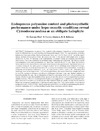Please use this identifier to cite or link to this item:
https://accedacris.ulpgc.es/jspui/handle/10553/46475
| Title: | Endogenous polyamine content and photosynthetic performance under hypo-osmotic conditions reveal Cymodocea nodosa as an obligate halophyte | Authors: | Zarranz Elso, M. García-Jiménez, P. Robaina, R. R. |
UNESCO Clasification: | 251004 Botánica marina | Keywords: | Cymodocea nodosa Fluorescence Obligate halophyte Polyamines Hypo-salinity, et al |
Issue Date: | 2012 | Publisher: | 1864-7782 | Journal: | Aquatic Biology | Abstract: | Endogenous polyamine (PA) content in the seagrass Cymodocea nodosa was monitored at different embryo and seedling developmental stages. Total PA concentration, including putrescine (Put), spermidine (Spd) and spermine (Spm), and the Put (Spm + Spd)−1 ratio decreased during embryo development, from the immature fruit to the mature seed stage (with a sharp decline in the free PA fraction), and subsequently increased during germination and seedling development from the cotyledon to seedling stage, indicating an important role during zygotic embryogenesis and seed germination. In particular, total levels of Put and Spm significantly decreased from the fruit to the mature seed, to be restored after germination. Spd levels remained constant during all the developmental stages studied. When seedlings were subjected to hypoosmotic stress (i.e. salinity decrease from 36 to 5 psu), fluorescence levels decreased, reaching a minimum photochemical efficiency (Fv/Fm) at 5 psu (0.582 ± 0.025, mean ± SE), indicating that seedlings were under high stress. Contrary to expectations, this was followed by a slight decrease in total PA content (showing a significance difference between 5 psu and higher salinities in bound-insoluble PA) and the accumulation of the PA cadaverine (Cad) at 5 psu (indicating cell death), which revealed the inability of this species to face the abiotic stress promoted by long-term salinity decrease. These 2 physiological indicators may suggest that C. nodosa is an obligate halophyte because it requires an environment with relatively high and stable salinity for its survival. Moreover, exogenous application of Spd significantly improved Fv/Fm values at the lowest salinity treatment (5 psu: 0.670 ± 0.012), which suggests a protective role of Spd in maintaining the photosynthetic apparatus of C. nodosa seedlings under long-term hypo-osmotic stress | URI: | https://accedacris.ulpgc.es/handle/10553/46475 | ISSN: | 1864-7782 | DOI: | 10.3354/ab00454 | Source: | Aquatic Biology [ISSN 1864-7782], v. 17, p. 7-17 |
| Appears in Collections: | Artículos |
SCOPUSTM
Citations
12
checked on Jun 8, 2025
WEB OF SCIENCETM
Citations
11
checked on Jun 8, 2025
Page view(s)
95
checked on Jul 27, 2024
Download(s)
106
checked on Jul 27, 2024
Google ScholarTM
Check
Altmetric
Share
Export metadata
Items in accedaCRIS are protected by copyright, with all rights reserved, unless otherwise indicated.
